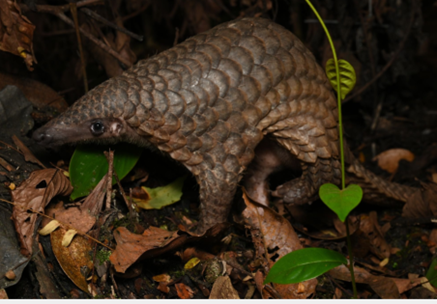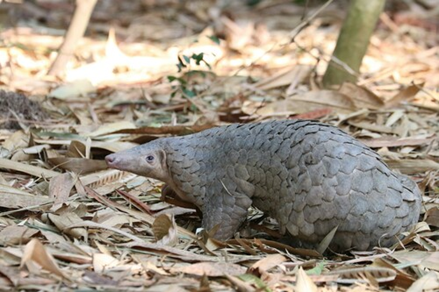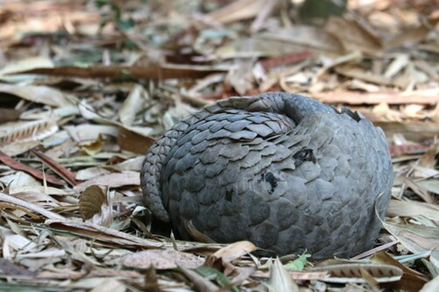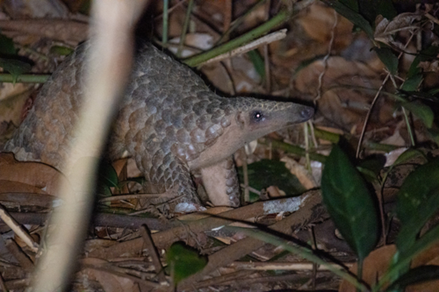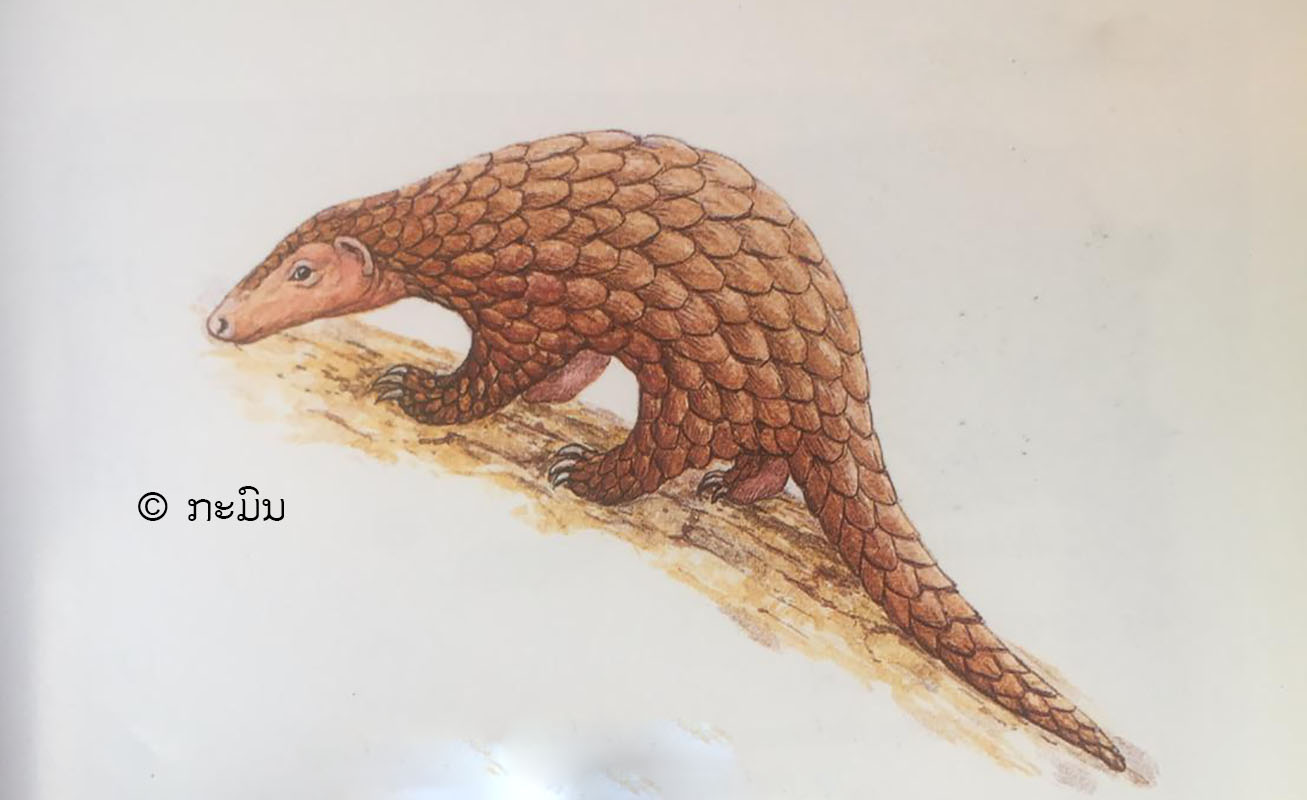ເລກລຳດັບທີ: 3602
ລະດັບການຮວບຮວມຂໍ້ມູນ: ຂໍ້ມູນພື້ນຖານ
ປັບປູງຄັ້ງລ່າສຸດ: 2024-10-19
ລິ່ນຄວາຍ
Chinese Pangolin
Manis pentadactyla Linnaeus, 1758
ສັດ
ສັດລ້ຽງລູກດ້ວຍນົມ
×
ຊື່ທ້ອງຖີ່ນ:
( Sunda Pangolin)
ຊື່ພ້ອງ
:
Manis pentadactyla subsp. aurita Hodgson, 183
Manis pentadactyla subsp. pusilla J.Allen, 1906
Manis pentadactyla subsp. pusilla J.Allen, 1906
ຊື່ສະກຸນ:
Manidae
ຊະນິດໃກ້ຄຽງ:
ລິ່ນງົວ/ Chinese Pangolin
ບັນຍາຍລັກສະນະທາງພືດສາດ:
ພວກລິ່ນ - Pangelins: ເຜົ່າ Pholidota
ລິ່ນເປັນເຜົ່າຍ່ອຍຂອງສັດເຂດ Afrotropical ແລະ Indomalayan ອາດເປັນເຜົ່າໃກ້ຄຽງກັບໂຕກິນມົດ, slothi ແລະ arinadilles ຢູ່ເຂດນີວໂອໂທຣປິກ ແລະ ກຸ່ມສັດລ້ຽງລູກດ້ວຍນົມຊະນິດອື່ນໆ Pholidota ມີຄວາມໝາຍວ່າສັດທີ່ມີເກັດ scaled mummas ທົ່ວໂລກມີ 7 ຊະນິດ ຢູ່ສປປ ລາວ ມີ 2 ຊະນິດ
ລິ່ນຕະກຸນຂອງ Manidae ພວກມັນເປັນສັດທີ່ມີເກັດຍາວຢູ່ທາງ ເບື້ອງຫຼັງຄ້າຍຄືແຜ່ນກະເບື້ອງມຸງຫຼັງຄາ, ເກັດດັ່ງກ່າວມີຄວາມໝາຍສຳຄັນດ້ານການປ້ອງກັນຕົວ ໂດຍສະເພາະເວລາມັນມ້ວນຕົວໃຫ້ເປັນຮູບມົນຄືໜ່ວຍບານ, ພວກມັນບໍ່ມີແຂ້ວແຕ່ມີລີ້ນທີ່ຍາວອາດຍືດອອກຈາກປາກໄດ້ເຖິງ 35-40 ຊມ. ພວກມັນກິນມົດ ແລະ ປວກເປັນອາຫານ, ພວກມັນອາດມີ ຫຼື ບໍ່ມີໃບຫູ, ມີຂອບຮິມຕາທີ່ໜາ ແລະ ມີກ້າມຊີ້ນສະເພາະເພື່ອປິດຮູດັງ
1. ລິນຄວາຍ / Manis javanica
ຫົວ ແລະ ລາຕົວຍາວ 40-65 ຊມ. ຫາງຍາວ 35-56 ຊມ. ໃຫຍ່ກວ່າລິ່ນງົວໜ້ອຍຫນຶ່ງ, ເລັບຕີນຫລັງຍາວກວ່າຕີນໜ້າ 2 ເທື່ອ, ເກັດກາງຫລັງເປັນຮູບກົມ, ອັດຕາສ່ວນຂອງຫາງຖ້າທຽບໃສ່ຄວາມຍາວທັງໝົດລໍາຕົວແມ່ນຫລາຍກວ່າ 0.42 ຊມ. ດັ່ງນັ້ນ, ເປັນທີ່ສັງເກດເຫັນວ່າມັນຍາວກວ່າລິ່ນງົວ 14-18 ຊມ, ຮອບຕົວມີເກັດ 16 ແຖວ, ແຕ່ລິ້ນງົວມີພຽງ 15-18 ແຖວ. ອຸປະນິໄສ: ເປັນສັດຫາກິນກາງຄືນ, ແຕ່ວ່າບາງເທື່ອກໍຫາກິນກາງເວັນກໍມີ. ອາໄສຢູ່ໃນຮູຕາມປົກກະຕິແລ້ວມັກຢູ່ໂດດດ່ຽວ, ຫາກິນຕາມພື້ນປາ ແລະ ປີນໄຕ່ຂຶ້ນ. ສຽງຮ້ອງ: ? ຖິ່ນອາໄສ: ພົບເຫັນຢູ່ຕາມປ່າຫລາຍຊະນິດທີ່ຢູ່ໃນເຂດລະດັບຕ່ຳລວມທັງປ່າຊັ້ນຫນຶ່ງ ແລະ ປ່າຊັ້ນສອງ, ມີຢູ່ທາງພາກໃຕ້ ແລະ ພາກກາງຂອງ ສປປ ລາວ ແຕ່ວ່າເຂດພາກເໜືອຍັງມີຂອບເຂດບໍ່ທັນຊັດເຈນ. ປະຈຸບັນນີ້ມີໜ້ອຍທີ່ສຸດຍ້ອນວ່າມີການລ່າໄປເປັນສິນຄ້າ ແລະ ໃນປ່າຈະພົບໄດ້ຍາກ.
ລິ່ນເປັນເຜົ່າຍ່ອຍຂອງສັດເຂດ Afrotropical ແລະ Indomalayan ອາດເປັນເຜົ່າໃກ້ຄຽງກັບໂຕກິນມົດ, slothi ແລະ arinadilles ຢູ່ເຂດນີວໂອໂທຣປິກ ແລະ ກຸ່ມສັດລ້ຽງລູກດ້ວຍນົມຊະນິດອື່ນໆ Pholidota ມີຄວາມໝາຍວ່າສັດທີ່ມີເກັດ scaled mummas ທົ່ວໂລກມີ 7 ຊະນິດ ຢູ່ສປປ ລາວ ມີ 2 ຊະນິດ
ລິ່ນຕະກຸນຂອງ Manidae ພວກມັນເປັນສັດທີ່ມີເກັດຍາວຢູ່ທາງ ເບື້ອງຫຼັງຄ້າຍຄືແຜ່ນກະເບື້ອງມຸງຫຼັງຄາ, ເກັດດັ່ງກ່າວມີຄວາມໝາຍສຳຄັນດ້ານການປ້ອງກັນຕົວ ໂດຍສະເພາະເວລາມັນມ້ວນຕົວໃຫ້ເປັນຮູບມົນຄືໜ່ວຍບານ, ພວກມັນບໍ່ມີແຂ້ວແຕ່ມີລີ້ນທີ່ຍາວອາດຍືດອອກຈາກປາກໄດ້ເຖິງ 35-40 ຊມ. ພວກມັນກິນມົດ ແລະ ປວກເປັນອາຫານ, ພວກມັນອາດມີ ຫຼື ບໍ່ມີໃບຫູ, ມີຂອບຮິມຕາທີ່ໜາ ແລະ ມີກ້າມຊີ້ນສະເພາະເພື່ອປິດຮູດັງ
1. ລິນຄວາຍ / Manis javanica
ຫົວ ແລະ ລາຕົວຍາວ 40-65 ຊມ. ຫາງຍາວ 35-56 ຊມ. ໃຫຍ່ກວ່າລິ່ນງົວໜ້ອຍຫນຶ່ງ, ເລັບຕີນຫລັງຍາວກວ່າຕີນໜ້າ 2 ເທື່ອ, ເກັດກາງຫລັງເປັນຮູບກົມ, ອັດຕາສ່ວນຂອງຫາງຖ້າທຽບໃສ່ຄວາມຍາວທັງໝົດລໍາຕົວແມ່ນຫລາຍກວ່າ 0.42 ຊມ. ດັ່ງນັ້ນ, ເປັນທີ່ສັງເກດເຫັນວ່າມັນຍາວກວ່າລິ່ນງົວ 14-18 ຊມ, ຮອບຕົວມີເກັດ 16 ແຖວ, ແຕ່ລິ້ນງົວມີພຽງ 15-18 ແຖວ. ອຸປະນິໄສ: ເປັນສັດຫາກິນກາງຄືນ, ແຕ່ວ່າບາງເທື່ອກໍຫາກິນກາງເວັນກໍມີ. ອາໄສຢູ່ໃນຮູຕາມປົກກະຕິແລ້ວມັກຢູ່ໂດດດ່ຽວ, ຫາກິນຕາມພື້ນປາ ແລະ ປີນໄຕ່ຂຶ້ນ. ສຽງຮ້ອງ: ? ຖິ່ນອາໄສ: ພົບເຫັນຢູ່ຕາມປ່າຫລາຍຊະນິດທີ່ຢູ່ໃນເຂດລະດັບຕ່ຳລວມທັງປ່າຊັ້ນຫນຶ່ງ ແລະ ປ່າຊັ້ນສອງ, ມີຢູ່ທາງພາກໃຕ້ ແລະ ພາກກາງຂອງ ສປປ ລາວ ແຕ່ວ່າເຂດພາກເໜືອຍັງມີຂອບເຂດບໍ່ທັນຊັດເຈນ. ປະຈຸບັນນີ້ມີໜ້ອຍທີ່ສຸດຍ້ອນວ່າມີການລ່າໄປເປັນສິນຄ້າ ແລະ ໃນປ່າຈະພົບໄດ້ຍາກ.
ນິເວດວິທະຍາ
ເຂດກະຈາຍພັນທົ່ວໂລກ:
Bangladesh, Bhutan, China, Hong Kong, India, Lao PDR, Myanmar, Nepal, Taiwan, Thailand, and Viet Nam.
(IUCN, 2024)
(IUCN, 2024)
ເຂດກະຈາຍພັນໃນລາວ
:
ເຂດລຽບແມ່ນ້ຳຂອງພາກໃຕ້
ພູພຽງບໍລິເວນ
ພູພຽງບໍລິເວນ

ເຂດກະຈາຍພັນຕາມພູມສັນຖານ
:
ປ່າດົງດິບ
ປ່າປະສົມປ່ຽນໃບ
ປ່າໄມ້ປ່ອງ
ປ່າເຫຼົ່າແກ່
ປ່າປະສົມປ່ຽນໃບ
ປ່າໄມ້ປ່ອງ
ປ່າເຫຼົ່າແກ່
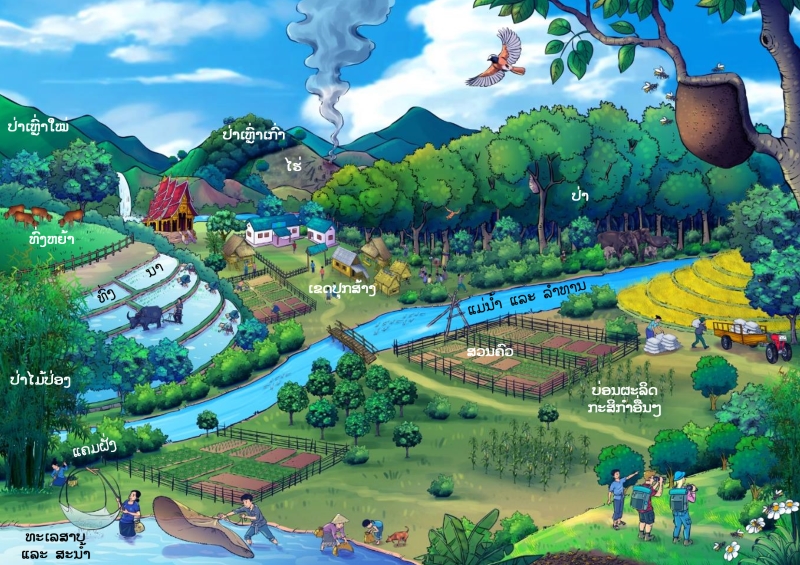
ສະເພາະຖິ່ນໃນລາວ:
ພື້ນເມືອງ
ຮຸກຮານ
:
ບໍ່ຮຸກຮານ
ສະຖານະພາບການອະນູຮັກ IUCN
:
ໃກ້ສູນພັນສູງສຸດ
ສະຖານະພາບການອະນຸຮັກແຫ່ງຊາດລາວ
:
ບັນຊີທີ່ I: ຊະນິດພັນປະເພດຫວງຫ້າມ
ການນຳໃຊ້
ປະເພດການນຳໃຊ້:
ການຄົມມະນາຄົມ
ອາຫານ
ອາຫານ
ບັນຍາຍການນຳໃຊ້:
ການປູກ ການລ້ຽງ:
ຊະນິດທຳມະຊາດ
ລະດູການເກັບກູ້:
ກຸມພາ
ມີນາ
ເມສາ
ພຶກສະພາ
ມິຖຸນາ
ກໍລະກົດ
ມີນາ
ເມສາ
ພຶກສະພາ
ມິຖຸນາ
ກໍລະກົດ
ການຕະຫຼາດ ແລະ ຕ່ອງໂສ້ມູນຄ່າ:
N/A
ການຄຸ້ມຄອງຈັດການ
N/A
ໂພຊະນາການ
ຄຸນຄ່າທາງໂພຊະນາການ:
ບັນຍາຍຄຸນຄ່າທາງໂພຊະນາການ:
N/A
| ສານອາຫານ | /100g | ໝາຍເຫດ |
|---|---|---|
| ໂປຣຕີນ | N/A | N/A |
| ຄາໂບໄຮເດຣດ | N/A | N/A |
| ໄຂມັນ | N/A | N/A |
| ວິຕາມິນ | N/A | N/A |
| ແຮ່ທາດ | N/A | N/A |
| ເສັ້ນໄຍ | N/A | N/A |
ອ້າງອິງ
ເຄດິດຮູບພາບ:
Sunda Pangolin in the daylight. [1] iNaturalist [Online]. Uploaded in February 2024 by: niran_anurakpongsathorn. Available: https://www.inaturalist.org/photos/352092134. [Accessed: 30 September 2024]
Sunda Pangolin curled up, action that they take for their own protection. [2] iNaturalist [Online]. Uploaded in February 2024 by: niran_anurakpongsathorn. Available: https://www.inaturalist.org/photos/352093480. [Accessed: 30 September 2024]
Sunda Pangolin in the nighttime. [3] iNaturalist [Online]. Uploaded in August 2024 by: axl_. Available: https://www.inaturalist.org/photos/415014644. [Accessed: 30 September 2024]
Sunda Pangolin curled up, action that they take for their own protection. [2] iNaturalist [Online]. Uploaded in February 2024 by: niran_anurakpongsathorn. Available: https://www.inaturalist.org/photos/352093480. [Accessed: 30 September 2024]
Sunda Pangolin in the nighttime. [3] iNaturalist [Online]. Uploaded in August 2024 by: axl_. Available: https://www.inaturalist.org/photos/415014644. [Accessed: 30 September 2024]
ອ້າງອິງ:
Francis, C. M. (2001). Mammals of Thailand & South-east Asia. Bangkok, Thailand: Asia book.
inaturalist. (2024, August 09). inaturalist. Retrieved from hubert_lam is a naturalist!: https://www.inaturalist.org/people/hubert_lam
IUCN. (2024, August o9). IUCN red list. Retrieved from IUCN red list: https://www.iucnredlist.org/species/12548/185202632
Johnson, A., & et_al. (2024). WILDLIFE IN LAO PDR 2024 STATUS REPORT. Vientiane capital, Laos PDR: Wildlife Conservation Society Lao PDR Program.
Min Sun, N. C., & et_al. (2024, August 12). Nursing Period, Behavior Development, and. Retrieved from https://journals.sagepub.com/home/trc: https://journals.sagepub.com/home/trc
prathumthong, D., & khlaipet, A. (2022). Mammals of nature world heritage Thong Yai Naresuan-Huai Kha khaeng. Thani province, Thailand: National Science Museum Thailand.
Thapa, P. A. (2024, August 12). An Overview of Chinese Pangolin (Manis. Retrieved from Google scholar: https://d1wqtxts1xzle7.cloudfront.net/105839771/8346-libre.pdf?1695221496=&response-content-disposition=inline%3B+filename%3DAn_Overview_of_Chinese_Pangolin_Manis_pe.pdf&Expires=1723452502&Signature=SfaMFMGtEp~QJAniTPtz1Sq6f-TMaTg7vWT8nrjJyKx12ko~BT6kl8wk
[1] Google schola “An Overview of Chinese Pangolin (Manis pentadactyla): Its General Biology, Status, Distribution and Conservation Threats in Nepal” [Online]. Available: https://bit.ly/3T8WqFp. [Accessed: 13 August 2024]
inaturalist. (2024, August 09). inaturalist. Retrieved from hubert_lam is a naturalist!: https://www.inaturalist.org/people/hubert_lam
IUCN. (2024, August o9). IUCN red list. Retrieved from IUCN red list: https://www.iucnredlist.org/species/12548/185202632
Johnson, A., & et_al. (2024). WILDLIFE IN LAO PDR 2024 STATUS REPORT. Vientiane capital, Laos PDR: Wildlife Conservation Society Lao PDR Program.
Min Sun, N. C., & et_al. (2024, August 12). Nursing Period, Behavior Development, and. Retrieved from https://journals.sagepub.com/home/trc: https://journals.sagepub.com/home/trc
prathumthong, D., & khlaipet, A. (2022). Mammals of nature world heritage Thong Yai Naresuan-Huai Kha khaeng. Thani province, Thailand: National Science Museum Thailand.
Thapa, P. A. (2024, August 12). An Overview of Chinese Pangolin (Manis. Retrieved from Google scholar: https://d1wqtxts1xzle7.cloudfront.net/105839771/8346-libre.pdf?1695221496=&response-content-disposition=inline%3B+filename%3DAn_Overview_of_Chinese_Pangolin_Manis_pe.pdf&Expires=1723452502&Signature=SfaMFMGtEp~QJAniTPtz1Sq6f-TMaTg7vWT8nrjJyKx12ko~BT6kl8wk
[1] Google schola “An Overview of Chinese Pangolin (Manis pentadactyla): Its General Biology, Status, Distribution and Conservation Threats in Nepal” [Online]. Available: https://bit.ly/3T8WqFp. [Accessed: 13 August 2024]
ຜູ້ສ້າງ Factsheet:
ຜູ້ກວດສອບ Factsheet:
,
